
- •Part I english in practice
- •Unit 1
- •I to slam - быстропрочитатьтекст,чтобыпонятьегоосновноесодержание
- •1 A) Education b extremely important for опт civilization. Some countries contributed greatly to the development of educational systems. Read the text
- •City traffic
- •Vocabulary list
- •Inventors and their inventions
- •Vocabulary
- •In the Train
- •I Rutherford c. Makintosh
- •I Colt s. Morsey
- •I Landau w. Thomson
- •1. A) Names of some people have become world famous thanks to their achievements. The name of Alfred Nobel is one of them. Read the words given below and find
- •Vocabulary list
- •Vocabulary
- •In the centre of New York;
- •Very far from New York.
- •Vocabulary list
- •Vocabulary
- •I can’t help you today. I’m too tied up with other things.
- •4 Heated factory premises - отапливаемые заводские помещения s assembly shop - сборочный цех ‘ skyscrapers - небоскребы
- •Impressions of modern architecture (a letter from england)
- •1. Прочитайте новые слова вслух, познакомьтесь с их русскими эквивалентами. Определите их значевш в данных предложениях.
- •Inspector: During the test you show eight road signs without legends and ask the driver to explain what he must do when he sees them.
- •Introduction
- •Vapour - пар to vaporize - испарять
- •It was a fine day, and many people were boating on the lake.
- •13: Fuelling stations are situated along the highway.
- •1,6. Can you repair my watch?
- •Isthmus - перешеек
- •In order to (prp)
- •10. Cloud There was not a cloud in the sky.
- •If he works hard at his English he will pass his exam well.
- •If the student observes the rules, he will not make mistakes.
- •Language material vocabulary
- •Pc means a personal computer language material vocabulary
- •1. Прочитайте номе слова вслух, познакомьтесь с их русскими эквивалентами. Определите их значения в данных предложениях.
- •8 Driver Drivers are one of the components of a
- •Volume Label
- •Important Safeguards
- •10. Power Source - The product should be connected to a power supply only of the type described in the operating instructions or as marked on the
- •Unit 13
- •IeMgzau
- •Introduction
- •I In setting up a business, the first thing to do is to estimate how much
- •Part II english in action
- •It’s evident that getting a job depends on many factors, among them
41.
HUGE огромный
He
is a man of huge strength.
Работа
со словарем. Прочтите предложения.
Определите исходную форму вцде-
ленных слов, часть речи, к которой они
относятся, и найдите соответствующие
значения
этих слов в словаре.
Ца)
A greater part of the research has been completed.
They
parted after they graduated from the Institute.
He
divided the apple into two parts.
a)
The trees were covered with snow and the forest looked beautiful.
It’s
raining hard, we must get under cover, quick!
This
book needs a new cover.
a)
The man tied his horse to the tree.
Family
ties are often very strong.
a)
It was getting dark and I could not see the shape of the building
clearly.
He
shaped a piece of clay into a ball.
He
likes to watch clouds of different shapes in the sky. ^ .
a)
The house is well placed, not far from the river.
They
hoped that the horse would get the first place in the race.
Place
the books in the right order.
a)
Storms sometimes cause great damage.
Several
valuable pictures were damaged by fire.
The
accident didn’t do much damage to the motor-car.
a)
There were large crowds in the streets.
People
quickly crowd round when there is a street accident.
The
pupils crowded round the teacher to ask questions.
a)
Concrete is widely used for bridge construction.
Concrete
units have been brought to the site.
The
word car
is
a concrete noun.
a)
High quality goods are manufactured at this plant.
The
steel manufacture has been considerably increased in the
last years.
The
shop manufactures engines for motor-cars.
Прочтите
следующие
интернациональные
слова вслух и, основываясь на
значевя** соответствующих
русских слов, определите их значения.
climate
[ klaimit] standard ['staendad]
tent
[tent] pyramid [ piramid]
170
I can’t help you today. I’m too tied up with other things.
primitive
[primitiv] cement [si'ment] oval ['ouval] conical ['konikl] period
['piariadj
sphinx
[sfinks] tourist f'tusnst] technique [tek'ni:k] industrialize
[in'dAStrialaiz] season ['si:zn]
4.
Выберите правильный
перевод слов из предложенных вариантов.
Найдите в каждом ряду слово, перевод
которого дан в начале ряда.
огромный a)
advanced, b) flat, с)
huge,
d) convenient
продолжитель- a)
advantage, b) duration, с)
establishment, ность
d) length
дорогой a)
main, b) concrete, c) previous, d) expensive
кроме
того a)
in turn, b) furthermore, c) without, d) still
отапливать a)
to heat, b) to tie, c) to increase, d) to extend
главный a)
shallow, b) recent, c) main, d) huge
преимущество a)
shortage, b) strength, c) effort, d) advantage
вытягивать,
рае- a)
to assemble, b) to expect, c) to extend, d) to ширять
rise
резать a)
to perform, b) to cut, c) to beat, d) to shake
единица a)
place, b) unit, c) shape, d) hole
собирать a)
to put up, b) to solve, c) to wear, d) to
assemble
передовой a)
advanced, b) expensive, c) ordinary, d) similar
нехватка a)
duration, b) damage, c) shortage,
d)
strength
связывать a)
to cut, b) to cover, c) to arouse, d) to tie
толпа a)
part, b) piece, c) crowd, d) unit
5.
Выберите слово, противоположное по
значению.
empty a)
proper, b) full, с)
dry, d) total
shallow a)
flat, b) huge, c) similar, d) deep
easy a)
above, b) difficult, c) main, d) successful
to
destroy a) to arouse, b) to cut, c) to build, d) to heat
huge a)
small, b) main, c) concrete, d) numerous
complicated a)
advanced, b) expensive, c) permanent,
d)
simple
to
assemble a) to cover, b) to part, c) to extend, d) to
manufacture
to
remain a) to assemble, b) to place, c) to leave, d) to put
up
strength a)
weakness, b) crowd, c) hole, d) brick
I 171
a)
still, b) never, с)
as well as, d) without a) to tie, b) to shape, c) to heat, d) to
restore always to
damage
Прочтите
н переведите следующие словосочетания
на русский язык
to
depend on quality in the middle of the wood to tie together
the
top of a wooden house £... to appear on the horizon [&*
J the
middle of the day a shallow hole to have no shape a flat ground to
put up a tent a stone wall to do something in turn the strength of
the material thick wood
to
serve as an explanation to destroy the city great effort advanced
workers steel and concrete numerous units to manufacture tubes
to
assemble houses the North Region to be made of bricks a new flat to
arouse interest in the wrong direction shortage of water the
assembly of aggregates the duration of the crises a number of
advantages to extend the road to heat the house expensive means huge
scale
to
play an important part to take part in the concert to take place to
be damaged by storm a damaged car an overcrowded bus a crowded
street
Решите
кроссворд.
1. The
... of Moscow is over
million.
2. The
highest part of a mountain.
3. A
construction material which was widely used in ancient times
4. The
main city of a country.
5. To
put several parts together.
6. A
waterway which links two seas.
7. To
make something shorter.
8. A
part of a country.
9. An
outside covering on the top of a
building.
10. One
of the qualities of fl
construction
material.
172
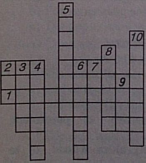
|
|
Active |
Passive |
|
Indefinite |
asking |
being asked |
|
Perfect |
having asked |
having been asked |
Bad
Habit
Lena
has a bad habit. She smokes. Her friends always tell her to stop
smoking. They say that smoking is unhealthy. Lena knows it, but
still keeps
173
on
smoking. She wants to stop, but she can’t. Smoking is a habit she
ju^ can’t break.
10.
Переведите следующие предложения на
русский язык, обращая внимание на геруд.
дий.
А;
Reading
English technical magazines is important for an engineer.
He
remembers having added some water to the mixture.
They
finished installing the apparatus only on Saturday.
They
began making the experiment in May.
After
failing his examination in January he had to take it again in
February.
After
graduating from the Institute he worked in the Far North.
At
the meeting they discussed different ways of improving their work.
There
are different ways of obtaining the substance.
The
organizers of the conference were informed of his refusing to take
part in it.
remember
his having been interested in languages in his* childhood. Б.
know
of his having been sent to work to the Far East.
What
is the reason for his having left our city so suddenly?
We
heard of the experiment having been started last week.
He
improved his report by changing the end.
They
objected to his staying at home.
Instead
of restoring the old theatre they decided to build a new one m the
centre of the town.
New
possibilities for applying atomic energy open up. f
It
is possible to set up power stations based on utilizing the heat о
the Sun.
The
idea of creating a multi-stage rocket belongs to Tsiolkovsky.
Before
being sent up the balloon was filled with a special gas.
What
apparatus do we use for measuring air pressure?
Science
requires experimenting.
Speaking
foreign languages is important for every educated man.
(обзорное).
Переведите следующие предложения на
русский язык, обр*®** внимание на
fog-формы.
The
monument needs restoring.
The
monument of what century are you restoring?
The
monument of what century is being restored?
174
|
Конверсия |
|
house | - дом, жилище, зда- Modem houses are comfortable, ние v - вмещать(ся), no- The building houses a library местить and a reading hall. |
1
Б.
haven’t
received an answer to my letter.
She
didn’t answer my last letter.
Concrete
has
become an important construction material.
The
large hole was concreted over.
He
carefully studied shape
of
the stones.
Clay
is easily shaped.
There
is no need to heat
the
substance.
I’m
suffering
from the heat. .
The
region is cut
into
two parts by the river.
There
was a deep cut
on
his hand.
We
couldn't find a dry place
anywhere.
Why
have they placed
die
bridge here?
The
child read the book from cover to cover.
Rivers
are covered
with
ice in winter.
а)
Назовите
русские
значения
следующих
предлогов:
abow,
on, tp, until
throughout, in front of about, in, of, with, from,
within, without.
б) Составьте
словосочетания с этими предлогами.
LISTENING
PRACTICE
Sometimes
people find themselves in desperate situations, but manage
to
find
a way out.
Listen
to the story “A Frenchman in London”. This story is about a man
who
found himself in a desperate situation.
Think
of the advice you could give him.
Listen
to the story up to the end and compare your plan for solving1
c
problem
with the Frenchman’s actions. Whose plan is better in У
opinion?
Answer
the following questions:
Who
came to London?
How
did the Frenchman spend his first day in London?
Why
couldn’t the Frenchman find the way back to the hotel?
176

What
way out of the situation did he find at last?
How
many telegrams did the Frenchman’s wife receive on that day?
Retell
tl\e story.
You are
the Frenchman’s wife. Tell your friends about your husband's
visit to London.
You
are the guide. Tell your friends about the Frenchman you took round
London the other day.
The
mystery of the Egyptian pyramids has always attracted scientists’
attention. But they have had quite different opinions about it.
Robert
F. believes that large blocks of stone were transported over long
distances by slaves and placed into position with the help of the
most primitive equipment.
Daniel
S. is sure that Egyptian pyramids are nothing but real mountains
covered with limestone slabs.
Joseph
D. came to the conclusion that the limestone slabs of the pyramids
were produced synthetically right on the construction site and so
there was no need of transporting them.
Louis
V. thinks that the Egyptian pyramids were constructed only thanks to
the help of visitors from other planets.
Listen
to the report “The Stones of the Pyramids”. This report was
made by one of the scientists mentioned above. You haven’t heard
the introduction. Try to guess the scientist’s name judging from
the information you have received.
Introduce
the scientist and say a few words about what he thinks about the
origin of the Egyptian pyramids.
Read
the transcript on p. 430. Look up the words you do not know in your
dictionary.
Ф
Speak about the explanation of the Egyptian pyramids’ construction
which
is
the most widespread;
is
the most unrealistic, in your opinion;
you
personally support.
177
ORAL
PRACTICE
Topic.
One
of the most beautiful buildings in the world.
Seven
human creations are considered to be wonders of the world. Now it is
possible to enlarge this number to include one more extraordinary
building either from Russia or abroad. Say a few words about it
giving information on
when
and where it was built;
who
it was designed by;
how
it looked before and how it looks now;
the
construction materials which were used;
how
the building was used before and how it is used now;
why
you think it should be considered one of the wonders of the
2. Pairwork.
Victor and his friend Paul have moved into a room in a new hostel.
The girls,Ann and Julia,are very curious about it.
Listen
to their conversation.
ANN:
Is your room large enough?
VICTOR:
Yes, I think it’s rather large.
JULIA:
Have you got any furniture there?
PAUL:
We have a sofa and a bed in it.
JULIA:
What about armchairs?
PAUL:
We haven’t got any armchairs yet. But it’s a good idea to have
an armchair, isn’t it? Now we’ve four chairs and a writing table
near the window.
ANN:
Don’t you have a TV set?
VICTOR:
Not in our room, but in the hall on the same floor.
ANN:
That’s not very convenient, is it?
PAUL:
That’s not quite right. We have so much fun when we watch 1
together with our friends. .
VICTOR:
1 suggest going to our room now and the girls can sCC
everything
with their own eyes.
PAUL:
Let’s go.
Complete
the following dialogues. i
\
A.:
Have you got any furniture? 2.A.:
...?
:...
Д. в.:
We haven’t got yet but...
: What
about...? A.:... :....
A.:
Don’t you have a TV set...? B.:
: It
is not so convenient, I’m afraid.
:
Think
of some good questions? for the following answers. The answers
needn’t be true.
Without
it. 6.
Nobody.
Above
all. 7. Everywhere.
In
the middle. 8.
You are wrong. Ш
The
crowd of people. 9. Unfortunately I can’t.
Comfortable
and convenient. 10.
Too expensive.
Paul’s
parents have bought a new flat. Now he has a room of his own.
He
is going to furnish it and so he asks his cousin Rita for advice.
Student A takes the part of Paul, and student В
the part of Rita.
Paul:
Your room is 4
m
long and 3 m
wide. You also-lTave a balcony. You have a sofa, a desk, two
armchairs, a bookshelf, a tape-recorder. Don’t forget to invite
your cousin to your house-warming party.
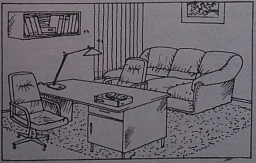
|
For |
Against |
|
|
b)
Discuss the problem in groups of 3-5 students in order to make »
decision.
180
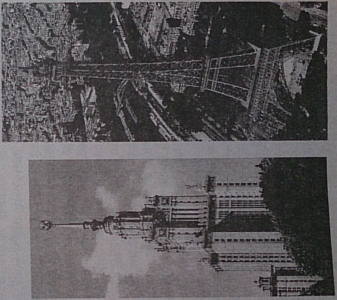
|
|
Group 1 |
Group 2 |
Group 3 |
Group 4 |
|
It is necessary to reconstruct old buildings. |
|
|
|
|
|
It is necessary to pull down old buildings. |
|
|
|
|
READING
PRACTICE
a)
Architecture is both science and art. Опт
life and our mood sometimes depend on the buildings around us. Read
the text about the history of architecture and rearrange the
illustrations on p. 183 according to the contents of the text.
TEXT
7 A THE
HOUSE
Man
has always been a builder. The kind of house he built depended upon
the climate, upon his enemies, and upon the building materials at
hand.
The first houses in many parts of the world were made of wood, for
in those days the greater part of the Earth was covered with
forests. Men tied together the tops of several trees and covered
them with the skins of animals or with leaves and grass. So a tent,
or hut, was the first house of the primitive people who lived where
there was much wood.
In
other regions the most convenient building material was stone. Men
began building houses out of stone very long ago. Although they were
built without cement, the remains of a few of them still exist.
It
appears that the most ancient homes on the territory of Russia were
earthenhouses. One such home was discovered near Voronezh in 1927.
It consisted of a shallow hole of oval shape. The floor was covered
with limestone slabs.1
The roof had been conical and stood on poles (столб)
covered by branches or animal skins. Such dwellings existed in that
part of the country in the Upper Paleolithic Period (from 40,000 to
12,000 years ago).
The
ancient Egyptians built very simple houses, by present standards.
Having dried the bricks in the sun, they put up four walls, and
above these they placed a flat roof. The roof was flat because
there was very little rain in Egypt. Although their buildings were
simple in construction, the Egyptian art of building was very
beautiful. Their pyramids and monuments,
182

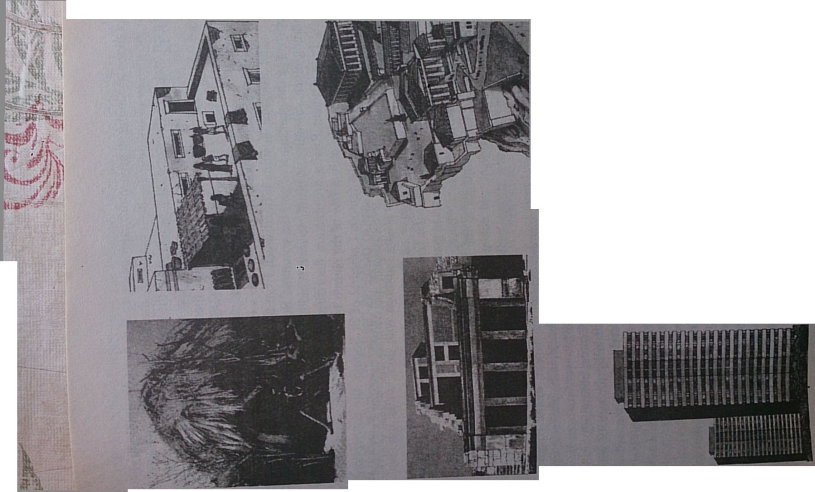
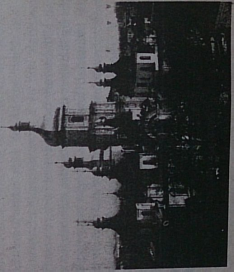
sphinxes
and palaccs arouse our admiration to
this day. An
important parl
in the history of building has been played by
the column, and it was
ancient
Egypt
that gave the world its first lessons in the
art of making columns
The
Greeks learned much from Egypt But
they did not borrow the
fl* roof They built a slanting roof because there
was much rain in their
country
The Greeks made the roof slant in two
directions from the
middle They also unproved on Egypt's columns and
soon became the
teachers of the world in column making.
The
Romans, in turn, learned much from the Greeks.
First of all they
borrowed
the slanting roof and the columns. But they added
the arch, thus
adding
much strength and beauty to their buildings.
In
Ancient Russia architecture flourished for
the first time in Kiev Russ
Unfortunately only a few of the church buildings of
that period have remained,
among them the famous Cathedral of St
Sophia, the cornerstone of
which was laid in 1037 to commemorate the victory
over the Pechenegs The
churches of that time were strong buildings with thick walls
and small windows
They often had to serve as fortresses against enemy
invasions During
the Second World War the finest ancient architectural monuments
were
destroyed and great effort has gone into restoring them.
In
the Middle Ages in Europe numerous wars betw&en different
nations
caused
great damages to the houses of crowded Medieval towns Therefore
many
monarchs and nobles built castles as a form of defence. Those
castles had very strong walls, narrow windows and projecting
fortifications.
The
Renaissance,
which was a European movement, lasted roughly from
the
14th to the 17th century. During this period, arts and
sciences underwent
great
changes. In architecture these changes were marked by a return
to
classical forms
and
proportions of ancient Roman buildings.
Buildings
of the 19th century are characterized by the use of new
materials
and by a great diversity of architectural styles. From the end
of
the 18th century iron and steel became widely used as alternatives
to wood, for by that Ume many countries experienced shortage of
this material. Later the Industrial Revolution brought
mass-production of building parts which were manufactured at a
factory and then simply assembled at a site.2
The
20th century is
notable
for widespread use of steel - reinforced
concrete
’
Huge
reinforced concrete units
manufactured in
heated factory premises4
are brought to the site which
becomes
something
like
an assembly shop
5
This technique has many advantages over
other building
method* First
of all it cuts the labour needed for building by 60 to
70%
and
extends
the
building season what is very important for countries
where winter
last5
